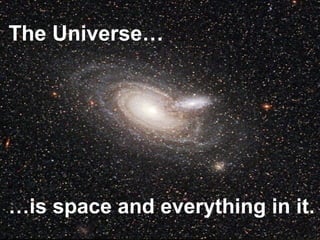
Galaxies and stars
- 1. The Universe… …is space and everything in it.
- 2. Galaxies A galaxy is a cluster of stars, gas, and dust that are held together by gravity. Thereare three main types of galaxies: Irregular Elliptical Spiral
- 3. Types of Galaxies – Irregular… Some galaxies do not have definable, regular shapes and are known as irregular galaxies. They contain young stars, dust, and gas.
- 4. Types of Galaxies – Elliptical... Ellipticalgalaxies look like flattened balls. These galaxies contain billions of stars, but have little gas and dust between the stars. Because of the lack of gas and dust, new stars cannot form in most elliptical galaxies, and so they contain only old stars.
- 5. Types of Galaxies –Spiral… Spiral galaxies consist of a flat, rotating disk with stars, gas, and dust and a central concentration of stars, known as the bulge. The bulge is surrounded by a much fainter halo of stars. Contains middle aged stars
- 6. Types of Galaxies – Barred Spiral… Our Milky Way galaxy has recently (in the 1990s) been confirmed to be a type of spiral galaxy known as a barred spiral galaxy. Our Sun is located at the edge of the Milky Way galaxy.
- 7. Nebulae (plural for Nebula) Stellar Nebula- A gigantic cloud of gas and dust from which stars are made; sometimes called a “Stellar Nursery” Planetary Nebula- When a star runs out of fuel to burn, its outer layers of gas are blown outward in the shape of a ring.
- 8. Stars A star contains hydrogen gas that forms helium through a process known as nuclear fusion. Stars form when gravity pulls together gas and dust from stellar nebula. Itreleases enormous amounts of energy which causes the star to become very hot and glow. Vary in mass, size, and temperature Held together by gravity.
- 9. A Star is Born… A star is made up of a large amount of gas, in a relatively small volume. A stellar nebula, on the other hand, is a large amount of gas and dust, spread out in an immense volume. All stars begin their lives as parts of stellar nebulas.
- 10. A Star is Born… Gravitycan pull some of the gas and dust in a nebula together. The contracting cloud is then called a protostar. A star is born when the contracting gas and dust become so hot that nuclear fusion begins.
- 11. Lifetimes of Stars… Beforethey can tell how old a star is, astronomers must determine its mass. Medium mass stars, such as the Sun, exist for about 10 billion years. These are known as main sequence stars.
- 12. Lifetimes of Stars… Starswith more mass have shorter lives than those with less mass. Small stars use up their fuel more slowly than large stars, so they have much longer lives, about 200 billion years.
- 13. Lifetimes of Stars… Stars form in a stellar nebula, from collapsing clouds of interstellar gas and dust. This is called a protostar. The rest of the life cycle depends on the mass of the When a star runs out of star. fuel, it will become a white dwarf, neutron star, or black hole.
- 14. Main Sequence Stars… Main Sequence is the stage in which stars spend the majority of their lifetime. Small and medium stars first become red giants. Theirouter layers expand during the red giant phase. Eventually, the outer parts grow bigger still and drift out into space.
- 15. Main Sequence Stars... Theblue, white, hot core is left behind causing a white dwarf. When there is no more energy, it becomes a black dwarf. It is the remaining burnt-out cinder left, as the star goes out.
- 16. A dying giant, or supergiant star, can suddenly explode. Within hours, the star blazes millions of times brighter. The explosion is called a supernova.
- 17. Neutron Stars… After a star explodes, some material from the star is left behind. This material may become part of a planetary nebula. Thecore will compress and form a neutron star. Neutron stars are even smaller and more dense than white dwarfs.
- 18. Black Holes… Themost massive stars may have more than 40 times the mass of the Sun. One might have more than five times the mass of the Sun left, after it becomes a supernova. The gravity of this mass is so strong that the gas is pulled inward, packing it into a smaller and smaller space. These massive stars become black holes when they die.
Notas do Editor
- http://commons.wikimedia.org/wiki/File:2MASX_J00482185-2507365_by_HST.jpg
- http://starchild.gsfc.nasa.gov/docs/StarChild/universe_level1/galaxies.html
- http://commons.wikimedia.org/wiki/File:I_Zwicky_18a.jpg
- http://commons.wikimedia.org/wiki/File:I_Zwicky_18a.jpg
- http://commons.wikimedia.org/wiki/File:2MASX_J00482185-2507365_by_HST.jpg
- http://www.nasa.gov/mission_pages/hubble/science/hstimg_ngc6217.html
- http://www.nasa.gov/multimedia/imagegallery/image_feature_768.html http://www.nasa.gov/multimedia/imagegallery/image_feature_77.html
- http://www.nasa.gov/mission_pages/spitzer/multimedia/spitzer20091123-b.html
- http://www.nasa.gov/multimedia/imagegallery/image_feature_21.html
- http://www.nasa.gov/audience/foreducators/topnav/materials/listbytype/Lifecycle_of_a_Star.html
- http://www.nasa.gov/multimedia/imagegallery/image_feature_468.html
- http://www.nasa.gov/multimedia/imagegallery/image_feature_219.html
- http://commons.wikimedia.org/wiki/File:M51_CHANDRA2.jpg
